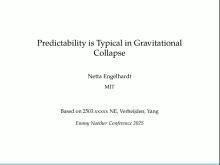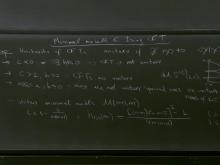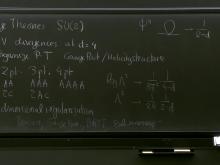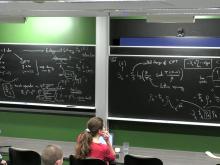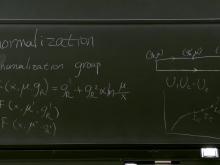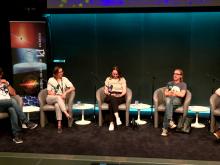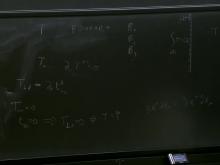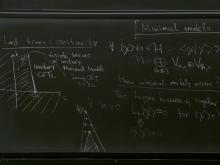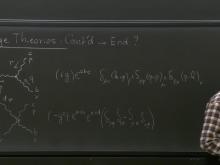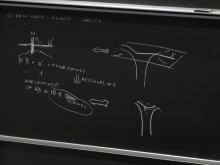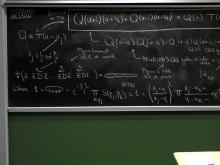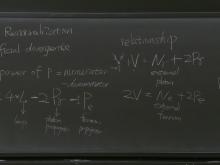Quantum field theory was originally developed as the extension of quantum mechanics needed to accommodate the principles of special relativity. Today quantum field theory is the modern paradigm with which we understand particle physics, condensed matter systems, and many aspects of early universe cosmology, and it is used to describe the interactions of elementary particles, the dynamics of many body systems and critical phenomena, all with exquisite accuracy. Currently, Perimeter researchers are producing world-leading advances in the study of integrability and scattering amplitudes in quantum field theories. String theory is a theoretical framework which was proposed to produce a unified description of all particles and forces in nature, including gravity. It is based on the idea that at very short distances, all particles should in fact be seen to be extended one-dimensional objects, i.e., ‘strings.’ Modern string theory has grown to be a broad and varied field of research with strong connections to quantum gravity, particle physics and cosmology, as well as mathematics. An exciting new framework known as ‘holography’ has emerged from string theory whereby quantum gravity is formulated in terms of quantum field theory in one less dimension. This symbiosis between quantum field theory and quantum gravity has been a focus of many Perimeter researchers. This has led to the development of exciting new methods to study the quantum dynamics of gauge theories and in the application of these techniques to new domains, such as nuclear physics and condensed matter physics
Format results
-
14 talks-Collection NumberC25017
Talk
-

Quantum Spacetime: from Speculation to Numbers
Renate Loll Radboud Universiteit Nijmegen
-

Quantum Gravity through the lens of Effective Field Theory
Alessia Platania University of Copenhagen
-

Planck-scale violations of relativistic symmetries in astrophysics and in quantum systems
Giulia Gubitosi University of Naples Federico II
PIRSA:25030057 -

Quantum Dynamics of Causal Sets: Results and Challenges
Sumati Surya Raman Research Institute
-

Ensembles of open quantum systems as a tool for quantum spacetime
Sarah Shandera Pennsylvania State University
-

Exploring the expanding Universe with the Dark Energy Survey
Jessica Muir University of Cincinnati
-

Gravitational waves as a window on gravity
Jocelyn Read California State University, Fullerton
-

Quantum Gravity in the era of Gravitational-Wave astronomy
Mairi Sakellariadou King's College London
-
-
Quantum Field Theory III, PHYS 777-, February 24 - March 28, 2025
13 talks-Collection NumberC25005Talk
-

Lecture - Quantum Field Theory III - PHYS 777
Jaume Gomis Perimeter Institute for Theoretical Physics
-

Lecture - Quantum Field Theory III - PHYS 777
Jaume Gomis Perimeter Institute for Theoretical Physics
-

Lecture - Quantum Field Theory III - PHYS 777
Jaume Gomis Perimeter Institute for Theoretical Physics
-

Lecture - Quantum Field Theory III - PHYS 777
Jaume Gomis Perimeter Institute for Theoretical Physics
-

Lecture - Quantum Field Theory III - PHYS 777
Jaume Gomis Perimeter Institute for Theoretical Physics
-

Lecture - Quantum Field Theory III - PHYS 777
Mykola Semenyakin Perimeter Institute for Theoretical Physics
-

Lecture - Quantum Field Theory III - PHYS 777
Mykola Semenyakin Perimeter Institute for Theoretical Physics
-

Lecture - Quantum Field Theory III - PHYS 777 (extra Lecture)
Mykola Semenyakin Perimeter Institute for Theoretical Physics
-
-
Quantum Field Theory II (Core), PHYS 603, November 12 - December 11, 2024
14 talks-Collection NumberC24035Talk
-

Lecture - QFT II, PHYS 603
Francois David CEA Saclay
-

Lecture - QFT II, PHYS 603
Francois David CEA Saclay
-

Lecture - QFT II, PHYS 603
Francois David CEA Saclay
-

Lecture - QFT II, PHYS 603
Francois David CEA Saclay
-

Lecture - QFT II, PHYS 603
Francois David CEA Saclay
-

Lecture - QFT II, PHYS 603
Francois David CEA Saclay
-

Lecture - QFT II, PHYS 603
Francois David CEA Saclay
-

Lecture - QFT II, PHYS 603
Francois David CEA Saclay
-
-
Beautiful Papers - October 7, 2024 - January 31, 2025
17 talks-Collection NumberC24043Talk
-

Lecture - Beautiful Papers
Pedro Vieira Perimeter Institute for Theoretical Physics
-

Lecture - Beautiful Papers
Pedro Vieira Perimeter Institute for Theoretical Physics
-

Lecture - Beautiful Papers
Pedro Vieira Perimeter Institute for Theoretical Physics
-

Lecture - Beautiful Papers
Pedro Vieira Perimeter Institute for Theoretical Physics
-

Lecture - Beautiful Papers
Pedro Vieira Perimeter Institute for Theoretical Physics
-

Lecture - Beautiful Papers
Pedro Vieira Perimeter Institute for Theoretical Physics
-

Lecture - Beautiful Papers
Pedro Vieira Perimeter Institute for Theoretical Physics
-

Lecture - Beautiful Papers
Pedro Vieira Perimeter Institute for Theoretical Physics
-
-
Quantum Field Theory I (Core), PHYS 601, October 7 - November 6, 2024
13 talks-Collection NumberC24034Talk
-

Lecture - QFT I, PHYS 601
Gang Xu Perimeter Institute for Theoretical Physics
-

Lecture - QFT I, PHYS 601
Gang Xu Perimeter Institute for Theoretical Physics
-

Lecture - QFT I, PHYS 601
Gang Xu Perimeter Institute for Theoretical Physics
-

Lecture - QFT I, PHYS 601
Gang Xu Perimeter Institute for Theoretical Physics
-

Lecture - QFT I, PHYS 601
Gang Xu Perimeter Institute for Theoretical Physics
-

Lecture - QFT I, PHYS 601
Gang Xu Perimeter Institute for Theoretical Physics
-

Lecture - QFT I, PHYS 601
Gang Xu Perimeter Institute for Theoretical Physics
-

Lecture - QFT I, PHYS 601
Gang Xu Perimeter Institute for Theoretical Physics
-
-
Celestial Holography Summer School 2024
27 talks-Collection NumberC24028Talk
-

Lecture - Celestial Holography Ia
PIRSA:24070002 -

Lecture - Canonical a
PIRSA:24070003 -

Lecture - Celestial Holography Ib
PIRSA:24070004 -

Lecture - Amplitudes a
PIRSA:24070005 -

Vision Talk
PIRSA:24070006 -

Lecture - Celestial Holography IIa
PIRSA:24070007 -

Lecture - Canonical b
PIRSA:24070008 -

Lecture - Celestial Holography IIb
PIRSA:24070009
-
-
String Theory 2023/24
13 talks-Collection NumberC24025Talk
-

String Theory Lecture
Davide Gaiotto Perimeter Institute for Theoretical Physics
-

String Theory Lecture
Davide Gaiotto Perimeter Institute for Theoretical Physics
-

String Theory Lecture
Davide Gaiotto Perimeter Institute for Theoretical Physics
-

String Theory Lecture
Davide Gaiotto Perimeter Institute for Theoretical Physics
-

String Theory Lecture
Davide Gaiotto Perimeter Institute for Theoretical Physics
-

String Theory Lecture
Davide Gaiotto Perimeter Institute for Theoretical Physics
-

String Theory Lecture
Davide Gaiotto Perimeter Institute for Theoretical Physics
-

String Theory Lecture
Davide Gaiotto Perimeter Institute for Theoretical Physics
-
-
QFT III 2023/24
13 talks-Collection NumberC24010Talk
-

QFT III Lecture
Jaume Gomis Perimeter Institute for Theoretical Physics
-

QFT III Lecture
Jaume Gomis Perimeter Institute for Theoretical Physics
-

QFT III Lecture
Jaume Gomis Perimeter Institute for Theoretical Physics
-

QFT III Lecture
Jaume Gomis Perimeter Institute for Theoretical Physics
-

QFT III Lecture
Jaume Gomis Perimeter Institute for Theoretical Physics
-

QFT III Lecture
Mykola Semenyakin Perimeter Institute for Theoretical Physics
-

QFT III Lecture
Mykola Semenyakin Perimeter Institute for Theoretical Physics
-

QFT III Lecture
Mykola Semenyakin Perimeter Institute for Theoretical Physics
-
-
Quantum Field Theory 2 2023/24
14 talks-Collection NumberC23045Talk
-
Twisted Holography Mini-Course
6 talks-Collection NumberC23050Talk
-

Twisted Holography Mini-Course - Lecture 20231102
Kevin Costello Perimeter Institute for Theoretical Physics
-

Twisted Holography Mini-Course - Lecture 20231109
Kevin Costello Perimeter Institute for Theoretical Physics
-

Twisted Holography Mini-Course - Lecture 20231116
Kevin Costello Perimeter Institute for Theoretical Physics
-

Twisted Holography Mini-Course - Lecture 20231123
Davide Gaiotto Perimeter Institute for Theoretical Physics
-

Twisted Holography Mini-Course - Lecture 20231130
Davide Gaiotto Perimeter Institute for Theoretical Physics
-

Twisted Holography Mini-Course - Lecture 20231214
Davide Gaiotto Perimeter Institute for Theoretical Physics
-
-
Quantum Spectral Curve and Three Point Functions mini-course
5 talks-Collection NumberC23049Talk
-

3pt function: No Q's
Pedro Vieira Perimeter Institute for Theoretical Physics
-

Q-functions in spin chains. QSC for spin chains
Paul Ryan King's College London
-

QSC definition in N=4
Paul Ryan King's College London
-

An explicit solution
Paul Ryan King's College London
-

3pt functions: Yes Q's
Pedro Vieira Perimeter Institute for Theoretical Physics
-
-
Quantum Field Theory 1 2023/24
13 talks-Collection NumberC23044Talk
-
Emmy Noether Workshop: Quantum Space Time
14 talks-Collection NumberC25017
Constructing a theory of quantum gravity, and with it a notion of quantum spacetime is one of the biggest challenges faced by modern theoretical physics. This workshop will bring together researchers from a wide range of viewpoints and give them an opportunity to exchange ideas and gain new insights.
The workshop is supported by the Simons Foundation.
:: :: ::
Workshop Speakers
Marcela Carena (Perimeter Institute)
Astrid Eichhorn (Universität Heidelberg)
Netta Englehardt (MIT)
Johanna Erdmenger (University of Würzburg)
Gulia Gubitosi (University of Naples Federico II)
Renate Loll (Radboud University)
Jessica Muir (Perimeter Institute)
A.W. Peet (University of Toronto)
Alessia Platania (University of Copenhagen)
Jocelyn Read (California State University, Fullerton)
Kasia Rejzner (York University)
Mairi Sakellariadou (King's College London)
Sarah Shandera (Pennsylvania State University)
Sumati Surya (Raman Research Institute)
Karen Yeats (University of Waterloo):: :: ::
Scientific Organizers
Bianca Dittrich (Perimeter Institute)
Sabrina Pasterski (Perimeter Institute)
Céline Zwikel (Perimeter Institute)
Sruthi Narayanan (Perimeter Institute) -
Quantum Field Theory III, PHYS 777-, February 24 - March 28, 2025
13 talks-Collection NumberC25005The course will cover the basics of conformal field theories and also some applications, including exact computations of the critical exponents in 2d statistical models. Instructor: Jaume Gomis/Mykola Semenyakin Students who are not part of the PSI MSc program should review enrollment and course format information here: https://perimeterinstitute.ca/graduate-courses -
Quantum Field Theory II (Core), PHYS 603, November 12 - December 11, 2024
14 talks-Collection NumberC24035This course introduces the functional integral formalism, the renormalization group, and non-abelian gauge theory. Additional topics may be covered as time allows. Instructor: Francois David / Gang Xu Students who are not part of the PSI MSc program should review enrollment and course format information here: https://perimeterinstitute.ca/graduate-courses -
Beautiful Papers - October 7, 2024 - January 31, 2025
17 talks-Collection NumberC24043Pedro will lead a mini-course (no credit) at Perimeter Institute. To express your interest in attending please complete this registration form (https://forms.office.com/r/nDQ6SDxSR4) by noon on Thursday, October 3. Pedro has selected 9 papers for this mini-course. -Infrared Photons and Gravitons by Weinberg, 1965 -Determination of an Operator Algebra for the 2D Ising Model by Kadanoff and Ceva, 1971 -Confinement of Quarks by Wilson, 1974, -Phenomenological Lagrangians by Weinberg, 1979, -Gravitational Effects on and of Vacuum Decay by Coleman and De Luccia, 1980 -Classical and Quantum Gravity Effects from Planckian Energy Superstring Collisions by Amati, Ciafaloni and Veneziano, 1987 -Quantum Spin Chains and The Haldane Gap by Affleck, 1988 -The Large N Limit of SFTs and Supergravity by Maldacena, 1997 -Entanglement Entropy and Quantum Field Theory by Calabrese and Cardy, 2008 If you think there are super nice papers that are missing that could be better than some of these in a particular topic please contact Pedro directly ([email protected]). The format will be: A] Pedro will give a 1h30m lecture about one of these papers on a Monday or a Friday (the Monday or Friday right after B] unless there is a holiday) B] One week later, X students give a presentation of Y minutes about important recent papers that refer/are related to that paper. At the end of this lecture we give feedback about those presentations. What is X and what is Y depends on how many students volunteer to present. Of course, people who just want to attend without presenting are also most welcome! Location: Alice Room, 3rd Floor, Perimeter Institute, 31 Caroline St N, Waterloo Recording/Zoom Details: Lectures will be recorded for PIRSA; Zoom link will be provided to registered participants. Building Access: Participants who do not have an access card for Perimeter Institute must sign in at the security desk before each session. When attending the lectures you can use the free self-serve coffee/water station on the ground floor. Meals and snacks at the on-site Black Hole Bistro are available at the full menu cost. -
Quantum Field Theory I (Core), PHYS 601, October 7 - November 6, 2024
13 talks-Collection NumberC24034The first half of the course explains why fields are desirable when quantum mechanics meets special relativity. The second half introduces different kinds of spinor fields and their interactions. Instructor: Gang Xu Students who are not part of the PSI MSc program should review enrollment and course format information here: https://perimeterinstitute.ca/graduate-courses -
Celestial Holography Summer School 2024
27 talks-Collection NumberC24028Perimeter Institute is happy to host the inaugural summer school for the Simons Collaboration on Celestial Holography July 22-26 in Waterloo, ON. The program will feature lectures on background material relevant for graduate students and postdocs interested in this emerging subfield, paired with vision talks on exciting future research directions.
:: :: ::
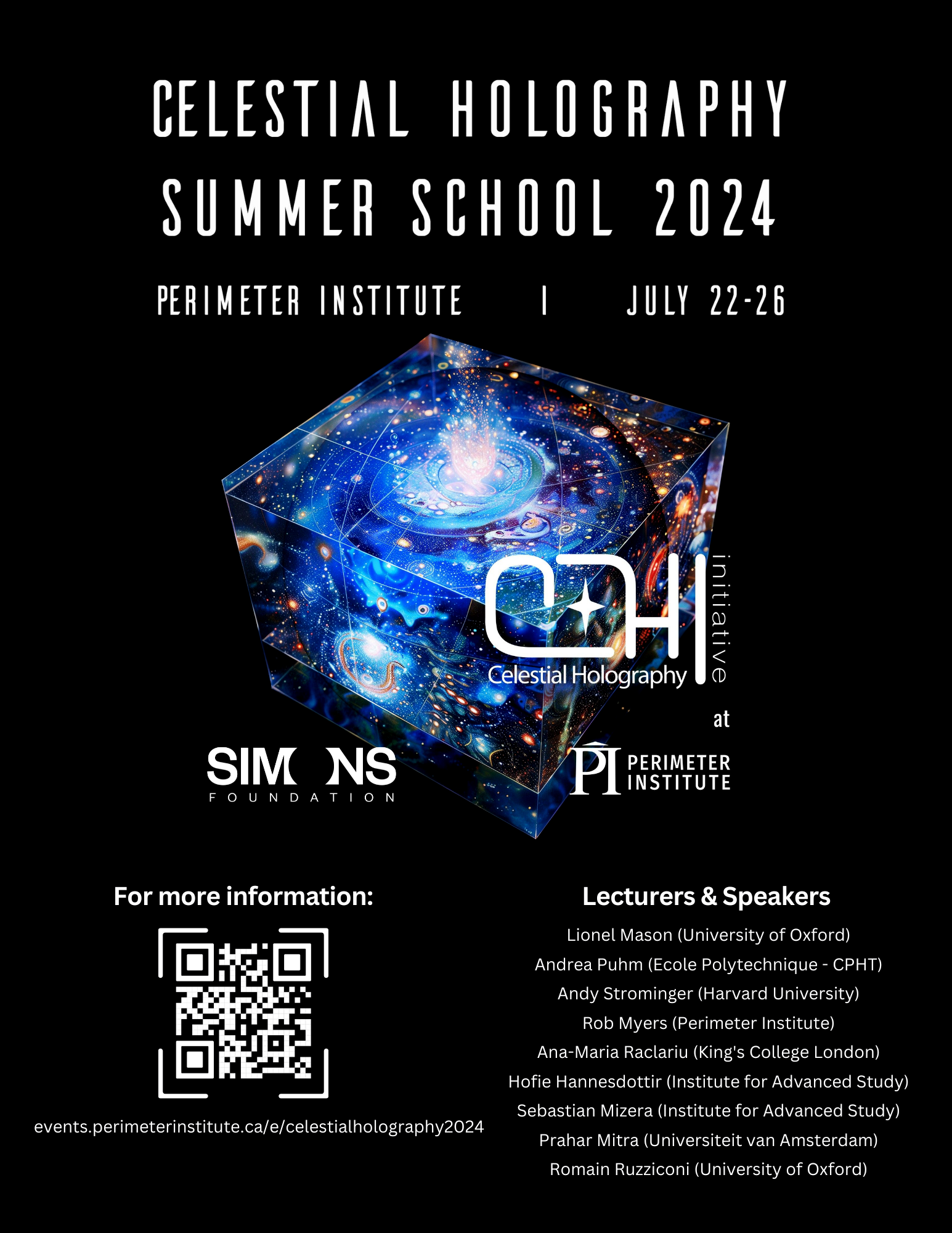
-
String Theory 2023/24
13 talks-Collection NumberC24025The course covers the basics of String Theory: bosonic strings, D-branes, a bit of superstrings.
-
QFT III 2023/24
13 talks-Collection NumberC24010This survey course introduces some advanced topics in quantum field theory and string theory. Topics may include anomalies, conformal field theory, and bosonic string theory and are subject to change depending on the topics covered in the TBD elective course.
-
-
Twisted Holography Mini-Course
6 talks-Collection NumberC23050This mini-course will introduce twisted holography, which is holography for BPS subsectors of gauge theory and gravity. We will start by introducing the B-model topological string from the space-time perspective, before discussing branes, backreaction, and the holographic duality.
Zoom: https://pitp.zoom.us/j/98839130613?pwd=SExFK0ZVYzJ3NmJhU1RFa21PWU1qQT09
-
Quantum Spectral Curve and Three Point Functions mini-course
5 talks-Collection NumberC23049In this mini-course we will describe some recent integrability developments in N=4 SYM. Pedro will start with some overview of three point functions in this theory. Paul will introduce the powerful Quantum Spectral Curve formalism describing the full planar spectrum of N=4 SYM starting with some elementary spin chain introduction. In this formalism, each operator in the theory is governed by a (set of) Q-function(s). In his last lecture Paul will walk us through an explicit example from beginning to end of a QSC solution. Pedro will then describe some explorations on three point correlation functions in this theory. The goal would be to have a machine where three Q-functions are given as input and a three-point function is spit out as output. We will describe where we are in this quest.
No Zoom link or hybrid participation available. Registration is not required.
-
